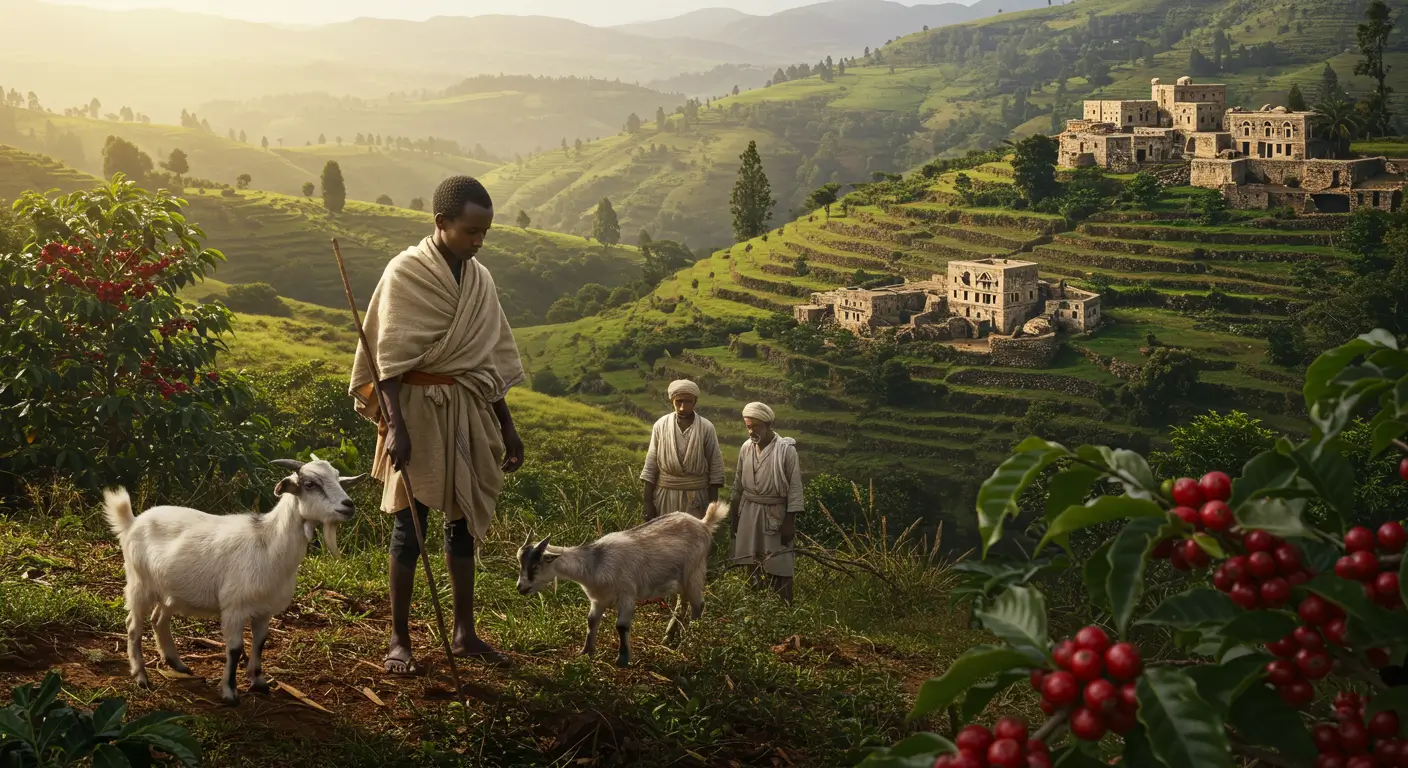
The Ancient Roots of Coffee

Table of Contents
ToggleThe Legend of Kaldi and the Discovery of Coffee
One of the most enduring tales in coffee history is the legend of Kaldi, an Ethiopian goat herder. According to the story, Kaldi noticed his goats behaving with unusual energy after eating the bright red berries from a particular plant. Intrigued, he tried the berries himself and experienced a similar burst of vitality. This discovery eventually led to the use of coffee beans to create a stimulating beverage. While the story is more folklore than fact, it beautifully illustrates how coffee might have first been recognized for its energizing properties.
This legend, though unverified, highlights Ethiopia’s central role in coffee’s origin. It’s a tale that resonates with coffee lovers, reminding us of the serendipitous moments that can change history. Whether Kaldi was real or not, the story underscores the mystical allure of coffee and its deep cultural significance.
Early Coffee Cultivation in Ethiopia and Yemen
Ethiopia is widely regarded as the birthplace of coffee, where the wild coffee plant, Coffea arabica, thrived in the lush highlands. The Oromo people are believed to have been among the first to recognize the potential of coffee, grinding the beans into a paste mixed with fat for sustained energy during long journeys or battles.
From Ethiopia, coffee made its way across the Red Sea to Yemen in the 15th century. Yemeni traders began cultivating coffee in the region’s fertile mountains, particularly in the port city of Mocha. This marked the beginning of coffee’s journey as a global commodity. The Yemenis perfected the art of cultivating and processing coffee, and Mocha became synonymous with high-quality beans. Here are some key points about early coffee cultivation:
- Ethiopia: The cradle of coffee, where wild Coffea arabica plants were first discovered and utilized by local tribes.
- Yemen: The first region outside Ethiopia to cultivate coffee, turning it into a thriving trade commodity.
- Mocha: A port city in Yemen that became a hub for exporting coffee to the rest of the world.
These early developments laid the foundation for the global coffee culture we know today, making Ethiopia and Yemen pivotal players in the history of this beloved beverage.
The Spread of Coffee Across the World
Coffee’s Journey to the Middle East and Europe
The story of coffee’s global journey begins in the ancient coffee forests of Ethiopia, where legend says a goat herder discovered the energizing effects of coffee beans. From there, coffee traveled across the Red Sea to Yemen, where Sufi monks brewed it to stay awake during long nights of prayer. By the 15th century, coffee had spread to Mecca and Medina, becoming a cornerstone of social and religious life in the Islamic world.
As trade routes expanded, coffee made its way to Europe in the 17th century. Venice, a hub of commerce, was among the first European cities to embrace the beverage. Initially met with suspicion and even labeled the “bitter invention of Satan,” coffee eventually won over the continent, thanks in part to the Pope’s approval. By the mid-1600s, coffee had become a staple in cities like London, Paris, and Vienna, symbolizing sophistication and intellectual exchange.
The Birth of Coffeehouses
The rise of coffeehouses marked a turning point in coffee’s history. In the Middle East, these gathering spots were called “qahveh khaneh” and served as centers for conversation, storytelling, and even business deals. When coffeehouses reached Europe, they became known as “Penny Universities” in England, where for the price of a cup of coffee, one could engage in lively debates, hear the latest news, or discuss philosophy and politics.
- In Constantinople, coffeehouses became hotspots for social interaction, often accompanied by music and poetry.
- In Paris, the Café Procope, founded in 1686, hosted figures like Voltaire and Rousseau, shaping the Enlightenment era.
- In England, Lloyd’s Coffee House evolved into the famous Lloyd’s of London insurance market.
Social Coffee Culture
As coffeehouses grew in popularity, they became catalysts for cultural and intellectual movements. These spaces were egalitarian, welcoming people from all walks of life to share ideas and form connections. Coffee culture fostered creativity, innovation, and even rebellion—some governments temporarily banned coffeehouses, fearing they would become hotbeds of dissent.
Over time, coffee became more than just a beverage; it became a ritual and a symbol of community. Whether sipped in the bustling streets of Istanbul or the elegant salons of Paris, coffee’s ability to bring people together remains one of its most enduring legacies.
The Rise of Specialty Coffee
Defining Specialty Coffee: What Makes It Unique?
Specialty coffee stands apart from your average cup of joe in several significant ways. At its core, it is defined by exceptional quality, starting from the bean itself. Specialty coffee beans are graded on a scale of 100, and to qualify as specialty, they must score 80 points or higher. These beans are often sourced from specific regions, known as terroirs, where the climate, soil, and altitude create unique flavor profiles.
Unlike mass-produced coffee, specialty coffee is meticulously grown, harvested, and processed. Farmers often employ sustainable practices, ensuring that the coffee is not only delicious but also ethically produced. The roasting process is equally important—specialty coffee is typically roasted in smaller batches to preserve its nuanced flavors. From espresso to pour-over, specialty coffee offers a sensory experience that celebrates the art and science of coffee-making.
The Third Wave Coffee Movement and Its Impact
The Third Wave Coffee Movement has been a game-changer in the world of coffee. Emerging in the early 2000s, this movement shifted the focus from coffee as a commodity to coffee as an artisanal product. It emphasizes transparency, quality, and sustainability, encouraging consumers to think about where their coffee comes from and how it’s made.
This movement has led to a deeper appreciation for the craftsmanship behind coffee. Baristas are now seen as skilled professionals who meticulously prepare each cup, while consumers are more invested in understanding the journey of their coffee—from farm to cup. The Third Wave has also popularized brewing methods like the Chemex, AeroPress, and siphon, allowing coffee lovers to explore new flavors and techniques.
Here are some key impacts of the Third Wave Coffee Movement:
- Increased Demand for Single-Origin Coffees: Consumers are now more interested in coffees sourced from specific regions, giving them unique and diverse tasting experiences.
- Focus on Sustainability: Ethical sourcing and environmental practices have become priorities for both producers and consumers.
- Rise of Independent Coffee Shops: The movement has fueled the growth of small, locally-owned cafes that prioritize quality over quantity.
Today, the Third Wave Coffee Movement continues to shape the industry, inspiring innovation and a deeper connection between coffee lovers and their brew.
The Role of Coffee Growing Regions
When it comes to specialty coffee, the region where the coffee is grown plays a pivotal role in shaping its flavor profile. Each coffee-growing region around the world has its own unique climate, soil composition, and altitude, all of which contribute to the terroir of the coffee. Understanding these factors can help coffee enthusiasts appreciate the nuances of their favorite brews and explore new flavors.
Key Coffee-Producing Regions and Their Unique Flavors
Let’s take a journey through some of the most renowned coffee-producing regions and discover what makes their beans so special:
- Latin America: Known for its bright acidity and balanced flavors, Latin American coffee often features notes of citrus, chocolate, and nuts. Countries like Colombia, Brazil, and Costa Rica are famous for their high-quality Arabica beans.
- Africa: African coffees, particularly from Ethiopia and Kenya, are celebrated for their vibrant acidity and complex flavor profiles. Think floral, fruity, and wine-like notes that make these beans stand out in a crowd.
- Asia-Pacific: This region, including Indonesia and Papua New Guinea, often produces coffees with earthy, spicy, and exotic flavors. These beans can have a heavier body, making them perfect for those who enjoy a bold cup.
The Importance of Terroir in Specialty Coffee
Terroir, a term borrowed from the wine industry, refers to the environmental factors that influence a coffee’s flavor. These include:
- Altitude: Higher altitudes often produce beans with more complex flavors and higher acidity, as the cooler temperatures slow the cherry’s ripening process.
- Soil: Volcanic, sandy, or loamy soils each contribute different nutrient profiles, affecting the coffee’s taste and aroma.
- Climate: Consistent rainfall and temperature fluctuations can enhance the bean’s development, leading to a more distinctive flavor.
Understanding terroir is essential for appreciating the craftsmanship behind specialty coffee. It’s not just about the bean—it’s about the land, the climate, and the care taken during cultivation. Next time you sip on a cup of specialty coffee, take a moment to savor the story behind its origins.
The Evolution of Coffee Brewing Techniques
Traditional Brewing Methods and Their Influence
For centuries, coffee brewing has been a ritualistic art, deeply rooted in tradition and culture. Methods like the Turkish ibrik and the pour-over technique have stood the test of time, shaping the way we enjoy our coffee today. The Turkish ibrik, for example, involves finely ground coffee simmered in water, often sweetened, creating a rich and aromatic experience. Meanwhile, the pour-over method, popularized in the early 20th century, emphasizes precision and control, allowing the drinker to extract the nuanced flavors of the coffee bean.
Traditional brewing methods share a common philosophy: simplicity meets craftsmanship.
- Turkish ibrik: A symbol of communal coffee culture.
- French press: Introduced in the 1920s, it’s known for its full-bodied flavor.
- Moka pot: Invented in 1933, it bridges espresso and drip coffee.
These methods laid the foundation for modern coffee brewing, proving that timeless techniques can still inspire innovation.
Modern Innovations in Coffee Preparation
In recent decades, the coffee world has witnessed a renaissance, driven by technology and a growing appreciation for specialty coffee. Espresso machines, once exclusive to cafes, are now a staple in many homes, offering barista-quality coffee at the push of a button. Similarly, cold brew systems have gained popularity, providing a smooth, low-acid alternative to traditional hot coffee.
Innovations like the AeroPress and siphon brewers have also emerged, combining elements of traditional methods with modern design. These tools cater to coffee enthusiasts who value experimentation and precision.
Here’s a quick look at some modern brewing innovations:
- Espresso machines: Precise pressure and temperature control.
- Cold brew systems: Ideal for a refreshing, slow-extracted coffee.
- AeroPress: Portable and versatile, perfect for travel.
- Siphon brewers: A fusion of science and art, delivering a clean cup.
These advancements not only enhance the brewing process but also encourage coffee lovers to explore new flavors and techniques.
The Impact of Specialty Coffee on Sustainability
Specialty coffee isn’t just about exceptional taste; it’s also about making a positive impact on the world. From ethical sourcing to environmental stewardship, the specialty coffee movement champions sustainability at every stage of the supply chain. Let’s explore how this commitment to sustainability shapes the coffee industry and why it matters to you as a coffee lover.
Ethical Sourcing and Fair Trade Practices
One of the cornerstones of specialty coffee is ethical sourcing. This means ensuring that coffee farmers are paid fairly for their hard work and that their rights are respected. Many specialty coffee roasters partner with cooperatives or directly with farmers, bypassing middlemen to ensure more equitable compensation.
- Fair Trade Certification: This ensures farmers receive a minimum price for their coffee, protecting them from market fluctuations.
- Direct Trade: Roasters work directly with farmers, fostering long-term relationships and often paying above-market rates.
- Transparency: Specialty coffee companies often share detailed information about the origins of their beans, empowering consumers to make informed choices.
By supporting ethically sourced coffee, you’re helping to improve the livelihoods of coffee-growing communities around the world.
Coffee Farming and Environmental Sustainability
Sustainability in coffee farming goes beyond fair wages—it’s about protecting the environment for future generations. Specialty coffee producers are leading the charge in adopting eco-friendly practices:
- Shade-Grown Coffee: Growing coffee under the canopy of trees preserves biodiversity and reduces the need for chemical pesticides.
- Organic Practices: Avoiding synthetic fertilizers and pesticides helps maintain soil health and protects local ecosystems.
- Water Conservation: Innovative techniques, such as rainwater harvesting, reduce water usage in coffee processing.
- Carbon Footprint Reduction: Many specialty coffee roasters offset their carbon emissions or invest in renewable energy.
These practices not only produce high-quality coffee but also ensure that the land remains fertile and productive for years to come.
When you choose specialty coffee, you’re not just indulging in a superior cup—you’re supporting a more sustainable and ethical coffee industry. Every sip is a step toward a better future for farmers, communities, and the planet.
The Future of Specialty Coffee
As the specialty coffee industry continues to evolve, it’s clear that innovation and sustainability will shape its future. Coffee enthusiasts and home baristas alike are witnessing exciting trends and technological advancements that promise to elevate the coffee experience even further. Let’s explore what’s on the horizon.
Trends Shaping the Future of the Coffee Industry
1. Sustainability Takes Center Stage: As consumers become more environmentally conscious, the demand for sustainable coffee practices is growing. From regenerative farming to composting coffee grounds, producers are finding innovative ways to reduce their environmental footprint.
2. Traceability and Transparency: Coffee drinkers are increasingly interested in the story behind their brew. Expect to see more emphasis on direct trade relationships and detailed information about the origin, farming practices, and roasting process.
3. Cold Brew and Nitro Coffee: These trendy beverages continue to gain popularity, offering a smooth, refreshing alternative to traditional hot coffee. Innovations in brewing techniques are making it easier for home baristas to experiment with these styles.
4. Personalization: The rise of customizable coffee experiences, from tailored flavor profiles to subscription services, is allowing consumers to explore their preferences like never before.
The Growing Role of Technology in Coffee Production
1. Smart Coffee Equipment: From app-controlled espresso machines to grinders with built-in scales, technology is making it easier than ever to achieve café-quality coffee at home. These tools are designed to be user-friendly while offering precision and consistency.
2. Advanced Processing Techniques: Innovations in fermentation and drying methods are unlocking new flavors in specialty coffee. Producers are experimenting with anaerobic fermentation and honey processing to create unique taste profiles.
3. Blockchain for Traceability: Blockchain technology is being used to enhance transparency in the coffee supply chain. This allows consumers to verify the authenticity and ethical sourcing of their coffee with just a few clicks.
4. AI and Machine Learning: From optimizing crop yields to predicting consumer preferences, artificial intelligence is playing a growing role in the coffee industry. These advancements are helping producers and roasters make data-driven decisions.
FAQ: The Future of Specialty Coffee
Q: What does sustainability mean in the coffee industry?
A: Sustainability in coffee focuses on environmentally friendly farming practices, fair wages for farmers, and reducing waste throughout the supply chain.
Q: How can I make a difference as a coffee consumer?
A: Support brands that prioritize direct trade, sustainability, and transparency. Experiment with brewing methods that minimize waste and invest in energy-efficient coffee equipment.
Q: What’s the best way to stay updated on coffee trends?
A: Follow specialty coffee blogs, join online communities, and attend coffee festivals or workshops to learn from experts and connect with fellow enthusiasts.
As we look to the future, one thing is certain: the world of specialty coffee will continue to inspire and innovate. Whether you’re a seasoned barista or a curious coffee lover, there’s never been a better time to explore this dynamic and ever-evolving industry.
is an editor at Coffee With Finance and a true coffee enthusiast. He explores roasts, flavors, origins, and brewing methods, sharing stories that captivate both beginners and experts. Petter believes great coffee sparks meaningful moments—and that includes simple, jargon-free talks about personal finance. His content blends aroma, flavor, and insight, making each coffee break an inspiring and enriching experience.




























Post Comment